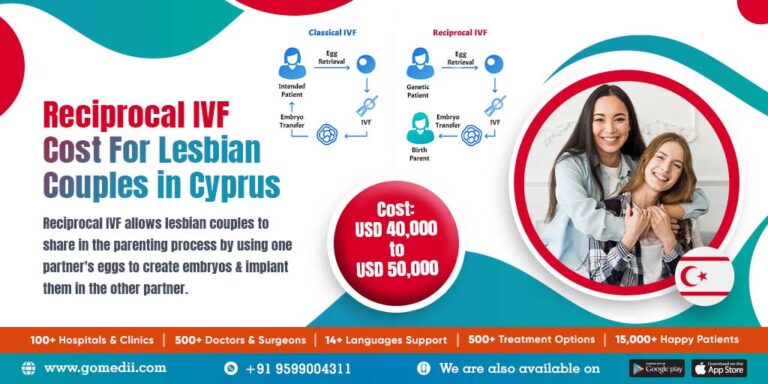
Are IVF Babies Normal?
April 14, 2025
Can You Choose the Gender with IVF?
April 14, 2025How Much Does Reciprocal IVF Cost? Your Complete Guide to Understanding the Price Tag

How Much Does Reciprocal IVF Cost? Your Complete Guide to Understanding the Price Tag
Reciprocal IVF is an incredible option for couples dreaming of starting a family together, especially for same-sex female partners or transgender individuals who want to share the journey of parenthood. One partner provides the eggs, while the other carries the baby—pretty amazing, right? But if you’re considering this path, one big question probably pops up: How much is reciprocal IVF going to cost me? It’s a fair question, and the answer isn’t one-size-fits-all. Costs can vary wildly depending on where you live, your insurance, and the unique steps your journey might include.
In this guide, we’re diving deep into everything you need to know about the price of reciprocal IVF. We’ll break down the numbers, explore hidden expenses, and share practical tips to make it more affordable. Plus, we’ll sprinkle in some fresh insights—like how recent trends in fertility care and new research might affect your wallet. Whether you’re just curious or ready to take the plunge, stick around. This is your roadmap to understanding the financial side of building your family.
What Is Reciprocal IVF, Anyway?
Reciprocal IVF, sometimes called partner-assisted IVF or shared motherhood, is a fertility treatment where one partner donates their eggs, and the other carries the pregnancy. It’s a beautiful way for both people to play a starring role in creating a baby—one provides the genetic material, and the other nurtures the little one through pregnancy. Donor sperm is used to fertilize the eggs in a lab, and then the resulting embryo is transferred to the partner who will carry the pregnancy.
This process mirrors traditional IVF in many ways, but it’s unique because it involves two people’s bodies in a coordinated dance of science and love. It’s especially popular among lesbian couples and trans men with functioning ovaries who want to feel deeply connected to their child’s creation. But with this teamwork comes a financial reality: reciprocal IVF often costs more than standard IVF because it involves procedures for both partners.
So, how much are we talking? Let’s get into the nitty-gritty.
The Big Picture: How Much Does Reciprocal IVF Cost?
The cost of reciprocal IVF can feel like a rollercoaster—it depends on so many factors that no two couples pay exactly the same. On average, though, you’re looking at a range of $15,000 to $30,000 per cycle in the United States. That’s a hefty chunk of change, but it’s just the starting point. Some clinics quote lower at around $12,000, while others climb past $30,000 if you add extras like genetic testing or multiple attempts.
Here’s a quick snapshot of what drives that price:
- Egg retrieval and stimulation: The partner donating eggs needs fertility drugs and monitoring, which can cost $7,000–$15,000.
- Embryo transfer and prep: The partner carrying the pregnancy needs their own meds and procedures, adding $3,000–$5,000.
- Donor sperm: A vial of sperm from a bank can run $400–$2,000.
- Lab fees: Fertilizing eggs and growing embryos in a lab? That’s another $2,000–$5,000.
And that’s just the basics. Costs shift based on where you are (New York City is pricier than rural Ohio), your clinic’s reputation, and whether your insurance chips in. Speaking of which…
Does Insurance Cover Reciprocal IVF?
Insurance is the wild card in this game. In the U.S., coverage for fertility treatments like reciprocal IVF varies by state, employer, and plan. As of 2025, 19 states have laws mandating some level of infertility coverage, but not all include IVF—and even fewer specify reciprocal IVF. Places like California and New York are more generous, while others leave you footing the bill.
Here’s the catch: even if IVF is covered, insurance might only pay for “medically necessary” cases—like if one partner has infertility issues. For many queer couples, reciprocal IVF is a choice, not a medical must, so insurers can say no. On average, only about 25% of Americans have IVF coverage, and it’s often partial—think consultations or a few meds, not the full ride.
✔️ Tip: Call your insurance provider and ask specifically about “reciprocal IVF” or “partner-assisted reproduction.” Get it in writing if they say yes!
❌ Heads-up: Don’t assume coverage for traditional IVF applies here—clarify every detail.
If insurance is a bust, don’t lose hope. We’ll talk about money-saving tricks later.

Breaking Down the Costs: What You’re Actually Paying For
To really get a handle on the price, let’s split it into pieces. Reciprocal IVF isn’t just one bill—it’s a series of steps, each with its own price tag. Here’s what you’re looking at:
Step 1: Fertility Testing for Both Partners
Before anything starts, both of you need a checkup. Blood tests, ultrasounds, and maybe an HSG (to check the uterus and tubes) can cost $1,000–$3,000 total. This makes sure the egg donor’s ovaries are ready and the carrier’s womb is good to go.
Step 2: Egg Stimulation and Retrieval
The egg donor takes hormone shots for about 10–14 days to pump up egg production. These meds? Pricey—$3,000–$10,000, depending on dosage (older donors often need more). Then, the egg retrieval surgery adds $4,000–$5,000. It’s a quick outpatient gig, but it requires anesthesia and skilled hands.
Step 3: Sperm Donation
You’ll need donor sperm, and costs vary. A single vial from a sperm bank ranges from $400 to $2,000, depending on whether you pick an anonymous donor or someone with a detailed profile (like education or hobbies). Some couples buy extra vials for future tries, so tack on more if that’s you.
Step 4: Lab Magic (Fertilization and Embryo Culture)
In the lab, sperm meets egg, and embryos grow for 3–5 days. This process—called fertilization and culturing—runs $2,000–$5,000. If you opt for fancy add-ons like ICSI (where sperm is injected directly into the egg), add $1,000–$2,000.
Step 5: Preparing the Carrier
The partner carrying the baby needs hormones to thicken their uterine lining—think estrogen and progesterone. That’s $1,000–$3,000 for meds, plus monitoring visits ($500–$1,000).
Step 6: Embryo Transfer
The big moment! Transferring the embryo into the carrier’s uterus is a simple procedure, costing $1,500–$3,000. If you freeze extra embryos for later, storage fees kick in at $500–$1,000 per year.
Extra Costs to Watch For
- Genetic testing (PGT): Screening embryos for health issues adds $3,000–$6,000.
- Multiple cycles: Only about 50–60% of cycles work for women under 35, so you might need 2–3 tries, doubling or tripling the total.
- Travel: If your clinic’s far, gas, flights, or hotels pile up.
Here’s a handy table to visualize it:
| Step | Cost Range | What’s Included |
|---|---|---|
| Fertility Testing | $1,000–$3,000 | Bloodwork, ultrasounds, HSG |
| Egg Stimulation | $3,000–$10,000 | Meds for egg donor |
| Egg Retrieval | $4,000–$5,000 | Surgery to collect eggs |
| Donor Sperm | $400–$2,000 | One vial from a sperm bank |
| Lab Fertilization | $2,000–$5,000 | Creating embryos |
| Carrier Prep | $1,500–$4,000 | Meds and monitoring for carrier |
| Embryo Transfer | $1,500–$3,000 | Placing embryo in uterus |
| Genetic Testing (opt.) | $3,000–$6,000 | Preimplantation screening |
| Embryo Storage (opt.) | $500–$1,000/year | Freezing extras for later |
Seeing it laid out like this can feel overwhelming, but knowledge is power. Knowing where the money goes helps you plan—and maybe even negotiate.
How Location Changes the Price
Where you live can swing the cost of reciprocal IVF by thousands. In the U.S., big cities like Los Angeles or Chicago charge more—think $20,000–$30,000 per cycle—because of higher clinic fees and living costs. Smaller towns might drop that to $12,000–$18,000.
But here’s a twist: some couples travel abroad to save cash. Countries like Mexico, Spain, and India offer reciprocal IVF for $4,000–$10,000 per cycle, including meds and donor sperm in some cases. The catch? You’ll need to factor in travel, lodging, and ensuring the clinic meets high standards. For example, World Fertility Services in India quotes around $7,000 for a full cycle—a steal compared to U.S. prices—but you’d need to vet their success rates and reviews.
✔️ Pro: International clinics can cut costs in half.
❌ Con: Language barriers or travel hiccups might stress you out.
Success Rates and Costs: Are You Paying for Results?
Reciprocal IVF’s success isn’t guaranteed, and that affects your budget. For women under 35, the live birth rate per cycle hovers around 50–60%, according to the Society for Assisted Reproductive Technology (SART). Over 35, it drops—sometimes to 30–40%—and keeps falling with age. If the egg donor’s older or the carrier has health issues, you might need more cycles, pushing your total past $50,000.
Here’s a fresh stat: a 2024 study from the American Society for Reproductive Medicine found that using younger egg donors (under 30) boosts success by 15% compared to donors over 35, even if the carrier’s older. So, if one partner’s under 30, letting them donate eggs could save you a second round.
Interactive Quiz: What’s Your Reciprocal IVF Budget?
Let’s make this fun! Answer these quick questions to estimate your starting point. Jot down your answers and tally them up.
- Where are you getting treatment?
- A) Big U.S. city ($20,000)
- B) Smaller U.S. town ($15,000)
- C) Abroad ($8,000)
- How old is the egg donor?
- A) Under 35 (+$0, higher success)
- B) 35–40 (+$5,000, might need extra cycle)
- Any extras like genetic testing?
- A) Yes (+$4,000)
- B) No (+$0)
Add your picks together. If you chose A/A/A, you’re at $24,000. B/B/A lands you at $24,000 too, but with a riskier success rate. C/A/B? Just $8,000! It’s not exact, but it gives you a ballpark.
Three Costs You Won’t Find in the Brochure
Most articles list the obvious expenses, but here are three sneaky ones that don’t get enough airtime:
1. Emotional Support Expenses
Fertility journeys can be an emotional marathon. Therapy or support groups—often $50–$150 per session—aren’t usually budgeted, but they’re lifesavers. A 2023 survey by Fertility Network found 70% of IVF patients sought mental health help, yet clinics rarely mention it.
2. Time Off Work
Egg retrieval and embryo transfer need recovery—sometimes a few days each. If you don’t have paid leave, lost wages could add $500–$2,000 per cycle, especially if both partners take time off.
3. Syncing Cycles
Some clinics sync the partners’ menstrual cycles with birth control pills before starting. It’s not always required, but when it is, it’s an extra $100–$500 in meds and visits that slips under the radar.
These might not break the bank, but they add up—and they’re worth planning for.
How to Make Reciprocal IVF More Affordable
Sticker shock hitting hard? Don’t worry—there are ways to lighten the load. Here are practical, creative ideas to stretch your dollars:
Shop Around for Clinics
Prices vary even in the same city. Call 3–5 clinics, ask for itemized quotes, and see if they offer package deals. Some bundle meds and monitoring for a flat rate—savings of $1,000–$3,000 aren’t uncommon.
Look for Grants
Organizations like Family Equality and BabyQuest Foundation offer grants for LGBTQ+ couples, sometimes covering $5,000–$15,000. Apply early—spots fill fast.
Mini IVF Option
Mini IVF uses lower-dose meds, dropping costs to $5,000–$10,000 per cycle. It’s less intense, so it might not work for everyone, but it’s a budget-friendly alternative if your doc gives the green light.
Split the Process
Freeze embryos now, transfer later. It spreads costs over months, avoiding a huge upfront hit. Freezing adds $500–$1,000, but it’s cheaper than a full second cycle.
Crowdfunding
More couples are turning to platforms like GoFundMe. A 2024 trend on X showed fertility fundraisers raising $2,000–$10,000 on average—proof your community might pitch in.
✔️ Action Step: Start a savings plan now—$500 a month for a year gets you $6,000 closer.
❌ Avoid: Super-cheap clinics with bad reviews—saving $2,000 isn’t worth a failed cycle.
Real Stories: What Couples Actually Paid
Numbers are great, but stories hit home. Here’s what two couples shared about their reciprocal IVF costs in 2024:
- Jess and Taylor (California): “We paid $22,000 total. Insurance covered testing ($2,000), but the rest—egg retrieval, sperm, transfer—was out of pocket. We did one cycle, used a $1,200 sperm donor, and got lucky on the first try.”
- Alex and Sam (Texas): “Ours hit $35,000 over two cycles. No insurance help, and we added genetic testing ($4,500). The second round worked, but we wish we’d budgeted for the emotional toll too—therapy was another $1,000.”
These real-world examples show how costs flex with luck, location, and choices.
Poll: What’s Your Biggest Cost Concern?
We want to hear from you! Pick one and drop your vote in your head (or share it with a friend):
- A) The upfront cost of one cycle
- B) The risk of needing multiple cycles
- C) Hidden extras like travel or therapy
What’s stressing you out most? It’s a big decision, and you’re not alone in weighing it all.
Fresh Research: What’s New in 2025?
Fertility science moves fast, and 2025 brings some game-changers that could tweak costs:
- AI-Powered Embryo Selection: A 2024 study from Stanford showed AI can pick the healthiest embryos with 85% accuracy, cutting the need for extra cycles. Clinics adopting this might charge $500–$1,000 more upfront but save you thousands long-term.
- At-Home Monitoring Kits: New tech lets you track hormones at home, reducing clinic visits. Early adopters report saving $300–$800 per cycle—ask your doc if they’re on board.
- Generic Fertility Drugs: Cheaper versions of IVF meds hit the market in 2024, slashing drug costs by 20–30% (think $2,000 savings on a $10,000 bill).
These breakthroughs aren’t everywhere yet, but they’re worth asking about.
Planning Your Reciprocal IVF Budget: A Step-by-Step Guide
Ready to crunch some numbers? Here’s a simple plan to figure out your costs:
- Call Your Insurance: Ask what’s covered—testing, meds, anything. Write it down.
- Pick a Clinic: Get quotes from at least three. Compare base prices and extras.
- Estimate Cycles: Assume 1–2 based on your ages and health. Multiply the clinic’s per-cycle cost.
- Add Extras: Donor sperm, travel, therapy—tack on what applies.
- Subtract Savings: Grants, insurance, or mini IVF discounts—factor those in.
Example: Clinic quotes $18,000/cycle. You plan for 2 cycles ($36,000), add $1,000 for sperm and $500 for travel ($37,500 total), then subtract a $5,000 grant. Your budget? $32,500. Adjust as needed!
The Emotional Price Tag: Beyond Dollars
Money’s one thing, but reciprocal IVF’s emotional cost deserves a shoutout. The highs of hope and lows of waiting can hit hard. Couples often say the shared experience—both partners being so involved—deepens their bond, but it’s still a marathon. Budgeting for self-care (a spa day, a weekend away) can keep you sane, even if it’s just $100–$200.
A 2023 study from the Journal of Reproductive Psychology found that couples who planned for emotional support were 30% less likely to drop out of treatment. So, don’t skimp here—it’s as vital as the meds.
Wrapping It Up: Is Reciprocal IVF Worth It?
So, how much is reciprocal IVF? Anywhere from $15,000 to $50,000+, depending on your path. It’s a big investment—in money, time, and heart—but for many, it’s the chance to build a family in a way that feels uniquely theirs. With smart planning, a little research, and some creative savings, you can make it work.
Think of it like planting a garden: it takes cash for seeds and tools, patience for growth, and care to see it bloom. Reciprocal IVF’s the same—you’re investing in something beautiful. Got questions? Talk to a clinic, chat with couples who’ve been there, or dive into online forums. Your family’s worth it, and you’ve got this.

